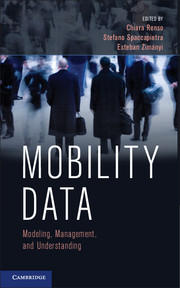Book contents
- Frontmatter
- Contents
- List of Contributors
- Preface
- Acknowledgments
- PART I MOBILITY DATA MODELING AND REPRESENTATION
- PART II MOBILITY DATA UNDERSTANDING
- 6 Mobility Data Mining
- 7 Understanding Human Mobility Using Mobility Data Mining
- 8 Visual Analytics of Movement: A Rich Palette of Techniques to Enable Understanding
- 9 Mobility Data and Privacy
- PART III MOBILITY APPLICATIONS
- PART IV FUTURE CHALLENGES AND CONCLUSIONS
- Bibliography
- Glossary
- Author Index
- Subject Index
- Plate section
8 - Visual Analytics of Movement: A Rich Palette of Techniques to Enable Understanding
from PART II - MOBILITY DATA UNDERSTANDING
Published online by Cambridge University Press: 05 October 2013
- Frontmatter
- Contents
- List of Contributors
- Preface
- Acknowledgments
- PART I MOBILITY DATA MODELING AND REPRESENTATION
- PART II MOBILITY DATA UNDERSTANDING
- 6 Mobility Data Mining
- 7 Understanding Human Mobility Using Mobility Data Mining
- 8 Visual Analytics of Movement: A Rich Palette of Techniques to Enable Understanding
- 9 Mobility Data and Privacy
- PART III MOBILITY APPLICATIONS
- PART IV FUTURE CHALLENGES AND CONCLUSIONS
- Bibliography
- Glossary
- Author Index
- Subject Index
- Plate section
Summary
Introduction
Visual analytics develops knowledge, methods, and technologies that exploit and combine the strengths of human and electronic data processing (Keim et al., 2008). Technically, visual analytics combines interactive visual techniques with algorithms for computational data analysis. The key role of the visual techniques is to enable and promote human understanding of the data and human reasoning about the data, which are necessary, in particular, for choosing appropriate computational methods and steering their work. Visual analytics approaches are applied to data and problems for which there are (yet) no purely automatic methods. By enabling human understanding, reasoning, and use of prior knowledge and experiences, visual analytics can help the analyst to find suitable methods for data analysis and problem solving, which, possibly, can later be fully or partly automated. In this way, visual analytics can drive the development and adaptation of computational analysis and learning algorithms.
Visualization is particularly essential for analyzing phenomena and processes unfolding in geographical space. Since the heterogeneity of the space and the variety of properties and relationships occurring in it cannot be adequately represented for fully automatic processing, exploration and analysis of geospatial data and the derivation of knowledge from it needs to rely upon the human analyst's sense of the space and place, tacit knowledge of their inherent properties and relationships, and space/place-related experiences. This applies, among others, to movement data.
- Type
- Chapter
- Information
- Mobility DataModeling, Management, and Understanding, pp. 149 - 173Publisher: Cambridge University PressPrint publication year: 2013
- 4
- Cited by



